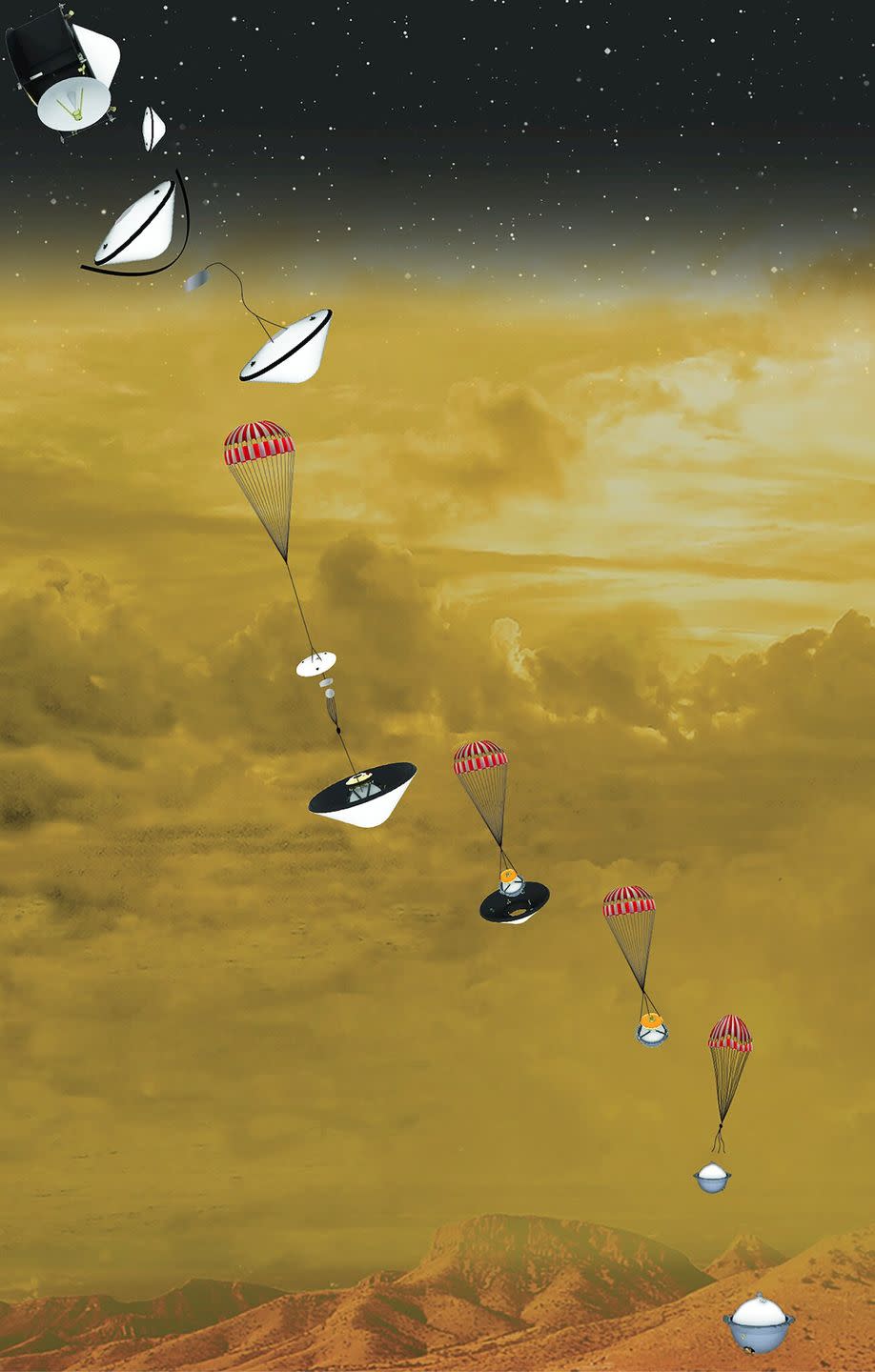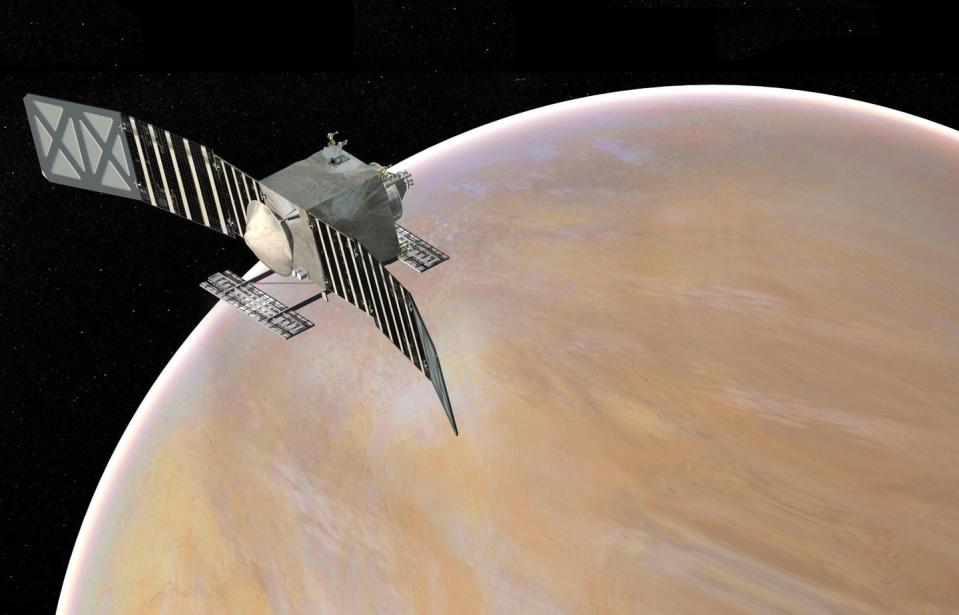At Long Last, NASA Is Going Back to Venus

NASA has announced the selection of its next two Discovery missions, set to launch later this decade.
The VERITAS and DAVINCI+ missions will explore the skies and map the surface of Venus in finer detail than ever before.
This will be the first time NASA sends a probe to our nearest planetary neighbor in over 30 years.
For the first time in over 30 years, NASA will visit Venus.
On Wednesday, the agency announced a pair of new missions, DAVINCI+ and VERITAS, will probe our nearest planetary neighbor starting between 2028 and 2030.
"These two sister missions both aim to understand how Venus became an inferno-like world capable of melting lead at the surface," NASA Administrator Bill Nelson said during the June 2 livestream touting the missions.
Both DAVINCI+ and VERITAS are part of NASA's Discovery program, and each will have a budget capped at $500 million. Previous Discovery missions include the upcoming asteroid missions Psyche and Lucy, as well as the groundbreaking Mars Pathfinder mission.
In February 2020, NASA unveiled four Discovery Mission concepts: two to Venus; one that would have explored Jupiter's volcanic moon, Io; and a fourth to Triton, a moon of Neptune. (Both VERITAS and DAVINCI were contenders for an earlier round of Discovery funding in 2017, but NASA selected the Psyche and Lucy missions instead.) Ultimately, the pull toward Earth's twin was stronger than that of the icy plumes and hot volcanoes in the outer solar system.
Earth and Venus have many characteristics in common. Both rocky planets are similar in size, mass, and composition, and researchers suspect early Venus may have even looked like Earth, with vast oceans. Then, something changed.
"Part of the question is when and how and why did Venus diverge the way it did? How did it become the hellish surface that it did?" Noam Izenberg, a DAVINCI+ science team member and planetary scientist at Johns Hopkins University Applied Physics Laboratory, tells Pop Mech. "Studying the only other Earth-like planet that we can up close will teach us so much more about Earth as well."
Venus Mission #1: DAVINCI+
DAVINCI+—that's Deep Atmosphere Venus Investigation of Noble gases, Chemistry, and Imaging—will investigate the Venusian atmosphere and surface to answer key questions about how it evolved over time.
Soon after the spacecraft arrives at Venus, it will lob a steel orb—filled with a suite of instruments encased in a wax-like material designed to protect them from extreme temperatures—to the planet's surface. Whereas Martian spacecraft (and their handlers back on Earth) have to endure the infamous 7 minutes of terror as they plunge through the atmosphere, Venusian probes are in for an even wilder trip.
"For Venus, it's like an hour-long hell ride," Izenberg says. As the spherical instrument plummets toward the Venusian surface, it will collect data on things like temperature, atmospheric pressure, and wind speed from the planet's atmosphere. It only has one shot to get it right.

"There's no second chance to send data back, which is incredibly exciting and incredibly nerve-wracking," Justin Filiberto, a planetary geologist at the Lunar Planetary Institute in Houston and one of the DAVINCI+ science co-investigators, tells Pop Mech. All of that information will sharpen scientists' understanding of the planet's infamous atmosphere.
The mission could help settle an important debate. Last year, scientists claimed to have found traces of the chemical phosphine—an indicator of life—in the planet's thick, acidic clouds. The results of their study weren't replicable, and one hypothesis suggests the phosphine could have been deposited into the atmosphere during volcanic activity. DAVINCI+ will look for traces of phosphine and chart the amount of sulfur in Venus's atmosphere—a key indicator of how volcanically active the planet is.
DAVINCI+ will snap high-resolution images of the planet, too. The probe will photograph massive, gnarled rock formations called tesserae. These unique Venusian features—perhaps relics of ancient continents—could be "some of the oldest rocks on the surface of Venus," Filiberto explains. And once the spacecraft deposits the probe, it will circle the planet and snap images of the planet's clouds in various wavelengths.
Venus Mission #2: VERITAS
VERITAS—Venus Emissivity, Radio Science, InSTAR, Topography, and Spectroscopy—will scan the surface of Venus in the highest resolution to date, providing imagery roughly 100 times sharper than Magellan, its predecessor of the 1990s. From its orbit around Venus, the spacecraft will use infrared emissions from rocks on the planet's surface to create a detailed geologic map.

A synthetic aperture radar aboard the spacecraft will develop a 3D topography map of Venus. These 3D images of the surface could shed light on how the planet formed and how it has changed over time. For other rocky worlds in the solar system, researchers typically use impact craters to estimate the relative ages of certain surface features and create a rough geologic timeline for the object. But on Venus, things are a little bit more complicated.
"The way I've always described Venus to people is that it is a structural geologist's dream and nightmare," Debra Buczkowski, VERITAS science team member and a planetary geologist at Johns Hopkins University Applied Physics Laboratory, tells Pop Mech.
Why? Because for starters, there are surprisingly few craters on Venus, which makes relative age dating difficult. On top of that, unlike rocks on Earth, which tectonic plates can bulldoze and weathering can dull, rocks on Venus don't erode.
"Unless it was covered by volcanic flow, everything that's ever happened to it is still there," Buczkowski says. "That means it's really hard for us to pick apart [Venus'] history because there are lots of overlapping structural features."
Some of the features that VERITAS will inspect are almost entirely unique to Venus. For example, a series of bizarre lava formations called coronae could indicate the crust is thinning in that region. “The only other place where there's something even remotely similar is Miranda, which is a moon of Uranus,” Buczkowski says.
Buczkowski is also excited to closely explore a series of flattened, circular landforms that barely jut out into the sky and, according to some hypotheses, may be smashed down under the pressure of Venus' thick atmosphere.
Venus is having a moment
Researchers hope DAVINCI+ and VERITAS could provide enough data to piece together Venus's complex geologic history. "The two missions are so complimentary to each other," Izenberg says. "It's really amazing and fantastic that they were both selected."
Lately, Venus is experiencing a renaissance. The new Venus-bound missions are a welcome return to a planet that some feel has been neglected in the last three decades. NASA's last mission to Venus, Magellan, wrapped up in 1994. In the ensuing decades, only the European Space Agency and Japan's space Agency, JAXA, have monitored Earth's twin with their respective Venus Express and Akatsuki missions.
Russia and India also have Venus missions in the works, and even private companies like Rocket Lab are getting in on the action. The selection of DAVINCI+ and VERITAS have only added fuel to the fire.
"We're really going to have to write brand new textbooks when both of [the missions] are over, because everything we know is going to change very quickly," Filiberto says.
🎥 Now Watch This:
You Might Also Like

